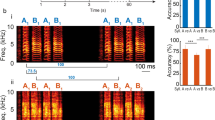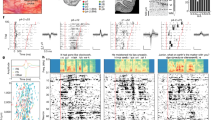Abstract
THE discovery that nerve fibres exhibit a refractory period which limits the number of impulses produced in a given time dealt a death blow to early ‘telephone’ theories, which postulated that information concerning the frequency of a tone (or a Fourier component of a complex sound) was faithfully reproduced by the rate of discharge of an individual fibre. Simple ‘telephone’ theories of neural encoding of pitch were replaced by ‘volley’ theories1 in which stimulus frequency was encoded in the auditory nerve as a whole. According to ‘volley’ theory, different fibres firing at sub-multiples of the stimulating frequency produce a composite discharge that faithfully reproduces the frequency of the stimulating wave-form.
This is a preview of subscription content, access via your institution
Access options
Subscribe to this journal
Receive 51 print issues and online access
$199.00 per year
only $3.90 per issue
Buy this article
- Purchase on Springer Link
- Instant access to full article PDF
Prices may be subject to local taxes which are calculated during checkout
Similar content being viewed by others
References
Wever, E. G., and Bray, C. W., Psychol. Rev., 37, 365 (1930). Troland, L. T., J. Gen. Psychol., 2, 28 (1929).
Derbyshire, A. J., and Davis, H., Amer. J. Physiol., 113, 476 (1935).
Peake, W. T., Tech. Rep. 365, Res. Lab. Electron., M.I.T. (1960). Peake, W. T., Goldstein, M. H., jun., and Kiang, N. Y.-S., J. Acoust. Soc. Amer., 34, 562 (1962).
Kemp, E. H., Coppee, G. E., and Robinson, E. H., Amer. J. Physiol., 120, 304 (1937).
Previous reports from this laboratory have described in greater detail the wave-forms of the SOC and the various techniques used. Interested readers are referred to Tsuchitani, C., and Boudreau, J. C., J. Neurophysiol., 27, 814 (1964); Boudreau, J. C., and Rohwer, J. W., U.S. Army Med. Res. Lab. Rep. No. 606 (1964); and Boudreau, J. C., J. Acoust. Soc. Amer. (in the press).
A Krohn-Hite band-pass filter, model 330 MR, was used with variable band-widths. The half amplitude cut-off points for the records in Fig. 1 were 0.5 kc/s and 11 kc/s.
A computer of average transients (CAT 400B, Technical Measurements Co.) and an enhancetron 1024 (Nuclear Data, Inc.) were used on different occasions. The latter had the advantage of on-line averaging of wave forms above 3 kc/s because of the greater number of memory channels available.
Hilali, S., and Whitfield, I. C., J. Physiol., 122, 158 (1953).
Galambos, R., Schwartzkopf, J., and Rupert, H., Amer. J. Physiol., 197, 527 (1959). Hall, J. L., Mass. Inst. Tech. Res. Lab. Electron. Tech. Rep., 416 (1964). Moushegian, G., Rupert, A., and Whitcomb, M. A., J. Neurophysiol., 27, 1174 (1964).
Author information
Authors and Affiliations
Rights and permissions
About this article
Cite this article
BOUDREAU, J. Neural Volleying: Upper Frequency Limits detectable in the Auditory System. Nature 208, 1237–1238 (1965). https://doi.org/10.1038/2081237a0
Issue Date:
DOI: https://doi.org/10.1038/2081237a0
This article is cited by
-
Spatial cross-correlation
Biological Cybernetics (1983)
Comments
By submitting a comment you agree to abide by our Terms and Community Guidelines. If you find something abusive or that does not comply with our terms or guidelines please flag it as inappropriate.



